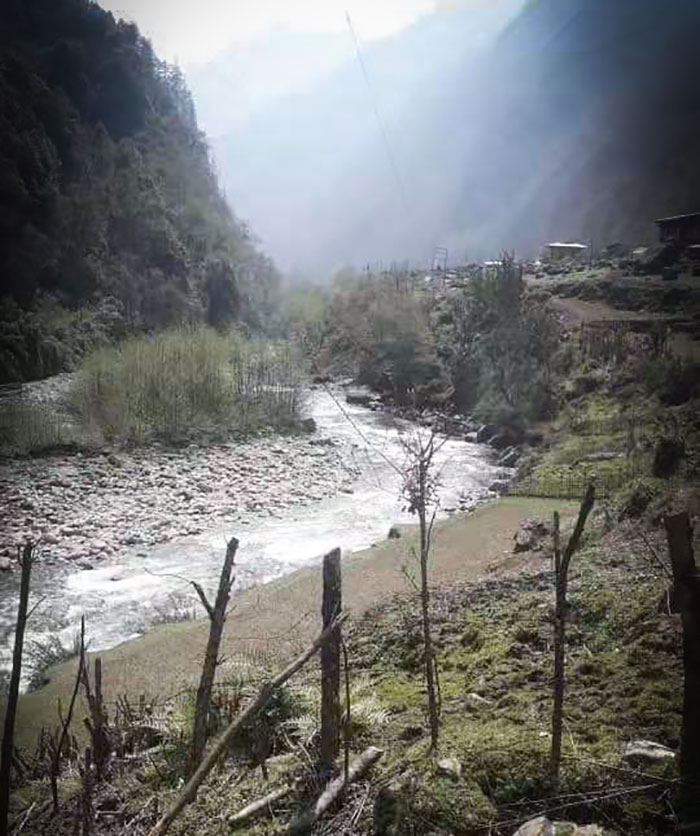
Tsang Ngo, a settlement along Khomachu
But looks for financial and technical assistance from elsewhere
The disaster management committee of Lhuentse dzongkhag has decided to conduct an in-depth study and assessment on the potential risk of glacial lake outburst flood (GLOF) to the low-lying areas of the dzongkhag. The decision was taken in a recent committee meeting attended by the dzongdag, gewog leaders, and other committee members.
The dzongkhag has decided to build flood protection walls in Tsikhang, Khoma, Sumpa, and Autsho town.
The meeting decided to seek support from the Department of Disaster Management (DDM), the National Centre for Hydrology and Meteorology (NCHM), and the Department of Geology and Mines (DGM) to save Lhuentse from potential threats of GLOF and flash floods.
The dzongkhag will consult relevant agencies and experts to install an early warning system at various locations where threats of lake outburst are real. The dzongkhag has limited capacity to carry out any study on such threats.
The committee chairperson, Dzongdag Jambay Wangchuk, told the meeting that the meeting’s sole purpose was to discuss the heightened risks associated with GLOF to low-lying areas of Lhuentse highlighted by this reporter’s story. He said the meeting was primarily deliberated on the implementation plan for risk reduction methods and frameworks to respond to GLOF.
Deliberations
The discussion focused on risk assessment and mitigation plans alongside Khomachu and the settlements in the Kurichu basin, particularly Autsho. Autsho has been identified as a high-risk area.
Dzongkhag Tshogdu (DT) chair and Jarey Gup, Kinzang Minjur, called for an extensive study to assess threats so that the dzongkhag could develop risk mitigation and adaptation mechanisms.
Chief DEO Ugyen Pem proposed that the history of threats and risks to people’s lives and infrastructure be studied for mitigation.
Khoma Mangmi Pema Tshering contented that the lake that posed the threat of GLOF is not Terjatse Tsho but Toh Toh Tse Tsho, which is likely to burst at any time. He said relevant agencies must carry out a risk assessment, hazard zonation and vulnerability to GLOF and artificial lakes for any intervention to begin.
Tsenkhar Gup Tsheten Wangdi echoed a similar view calling for flood protection walls and identifying safe places in the event of a natural disaster.
DT chair informed the meeting that Tsatichu artificial lake, which falls under Mongar Dzongkhag, was least likely to burst. Druk Green Power Corporation, in an earlier report, stated that the lake did not pose any threat, but there is no update on the status of the lake.
Tsamang Gup Sonam Dargay said that, although the artificial lake did not pose an imminent threat, it was important to be prepared for any possible danger.
Response from agencies
Lhuentse dzongkhag is planning to seek support for mitigating the twin risks of GLOF and artificial lake outburst from DDM, NCHM and DGM. However, these agencies are not in a position to support the dzongkhag financially. Instead, they suggest an “integrated approach” to disaster response, whereby they provide technical support and the dzongkhag mobilises financial resources.
The chief of the Risk Prevention and Reduction Division from DDM, Thinley Norbu, suggests that the dzongkhag disaster committee prepare a contingency plan for risk reduction and implementation. The department expects to receive an official confirmation from Lhuentse dzongkhag on a systematic approach and a preparedness contingency plan.
Meanwhile, the director of NCHM, Karma Dupchu, said there was no need to install an early warning system for Kurichu as settlements are limited to Autsho, a small community. He added that people could be alerted of an impending disaster even without an early warning system in place as long as they are connected to mobile networks. “Moreover, we have our technicians placed in Sumpa, Autsho and Kurizampa to inform people about floods,” he said.
Karma Dupchu said the installation of an early warning system needed to be studied from the cost-benefit point of view because it was challenging to operate it as maintenance is laborious.
However, the chief of Hydrology and Water Resources Services Division of NCHM, Tayba Buddha Tamang, said an early warning system for the Kurichu basin would be definitely activated in the future. “Currently, we’re working for Wangchu in Thimphu and Pachu in Paro,” he said.
For this to happen, the dzongkhag has to mobilise funds to conduct study and assessment for potentially dangerous glacier lakes as NCHM does not have financial resources.
Chief glaciologist of Cryosphere Service Division of NCHM, Karma Toep, said, “We can provide critical apparatus and technical expertise only if the dzongkhag mobilises financial resources with a systematic approach to conduct an assessment for Terjatse Tsho.” He suggests a broad, holistic approach if the early warning system has to be activated in the Kurichu basin.
DGM has no plan to update its study on the stability of Tsatichu artificial lake and risk assessment as there is no proposal to do so from either Lhuentse or Mongar dzongkhags.
The director general of DGM, Choiten Wangchuk, recommends that dzongkhag formally seek technical assistance and expertise if there is a need to conduct a re-assessment for Tsatichu artificial lake.
Meanwhile, the coordination among different government agencies to mitigate the threats of GLOF and artificial lake outburst of floods is hinged on financial resources that none of them has.
Contributed by
Sonam Lhendup
(This story is supported by Bhutan Media Foundation’s Climate Change Reporting Grant.)

